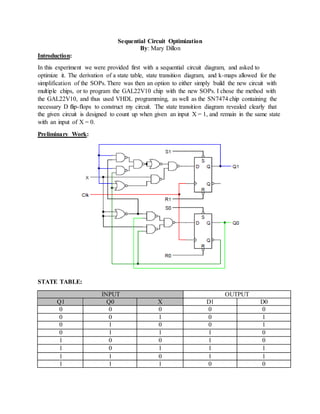Report
Share

Recommended
Recommended
More Related Content
What's hot
What's hot (18)
Original N-Channel Mosfet SMK630 SMK630D 9A 200V SOT-252 New KODENSHI

Original N-Channel Mosfet SMK630 SMK630D 9A 200V SOT-252 New KODENSHI
Original Digital Transistor KRC105 C105M C105 100mA 50V TO-92 New

Original Digital Transistor KRC105 C105M C105 100mA 50V TO-92 New
Original IGBT AOTF15B60D2 TF15B60D2 TF15B60 15B60 TO-220F IGBT 600V 15A New

Original IGBT AOTF15B60D2 TF15B60D2 TF15B60 15B60 TO-220F IGBT 600V 15A New
Original IGBT SGF23N60UFD G23N60UF G23N60 23N60 600V 23A New

Original IGBT SGF23N60UFD G23N60UF G23N60 23N60 600V 23A New
Original N-Channel Mosfet IC 20N15GH 20N15 TO-252 New Advanced Power Electron...

Original N-Channel Mosfet IC 20N15GH 20N15 TO-252 New Advanced Power Electron...
RF Module Design - [Chapter 7] Voltage-Controlled Oscillator![RF Module Design - [Chapter 7] Voltage-Controlled Oscillator](data:image/gif;base64,R0lGODlhAQABAIAAAAAAAP///yH5BAEAAAAALAAAAAABAAEAAAIBRAA7)
![RF Module Design - [Chapter 7] Voltage-Controlled Oscillator](data:image/gif;base64,R0lGODlhAQABAIAAAAAAAP///yH5BAEAAAAALAAAAAABAAEAAAIBRAA7)
RF Module Design - [Chapter 7] Voltage-Controlled Oscillator
Original IGBT STGF14NC60KD STGF14NC60 14NC60 14A 600V TO-220 New STmicroelect...

Original IGBT STGF14NC60KD STGF14NC60 14NC60 14A 600V TO-220 New STmicroelect...
Similar to Sequential Circuit Optimization
Similar to Sequential Circuit Optimization (20)
Stanley a Meyers analysis and test results of gated pulse frequency generator...

Stanley a Meyers analysis and test results of gated pulse frequency generator...
Assignment 1 Description Marks out of Wtg() Due date .docx

Assignment 1 Description Marks out of Wtg() Due date .docx
November 21, 20131How a Diode WorksA diode is an electrica.docx

November 21, 20131How a Diode WorksA diode is an electrica.docx
The iot academy_embeddedsystems_training_circuitdesignpart3

The iot academy_embeddedsystems_training_circuitdesignpart3
Sequential Circuit Optimization
- 1. Sequential Circuit Optimization By: Mary Dillon Introduction: In this experiment we were provided first with a sequential circuit diagram, and asked to optimize it. The derivation of a state table, state transition diagram, and k-maps allowed for the simplification of the SOPs. There was then an option to either simply build the new circuit with multiple chips, or to program the GAL22V10 chip with the new SOPs. I chose the method with the GAL22V10, and thus used VHDL programming, as well as the SN7474 chip containing the necessary D flip-flops to construct my circuit. The state transition diagram revealed clearly that the given circuit is designed to count up when given an input X = 1, and remain in the same state with an input of X = 0. Preliminary Work: STATE TABLE: INPUT OUTPUT Q1 Q0 X D1 D0 0 0 0 0 0 0 0 1 0 1 0 1 0 0 1 0 1 1 1 0 1 0 0 1 0 1 0 1 1 1 1 1 0 1 1 1 1 1 0 0
- 3. VHDL CODE: library IEEE; use IEEE.STD_LOGIC_1164.all; entity deathstar is PORT( X : in std_logic; Q_0 : in std_logic; Q_1: in std_logic; D1: out std_logic; D2 : out std_logic); end deathstar; architecture deathstar of deathstar is begin -- enter your EQUATIONS here D1 <= ((not Q_1) and Q_0 and X) OR (Q_1 and (not X)) OR (Q_1 and (not Q_0)); D2 <= ((not Q_0) and X) OR (Q_0 and (not X)); end deathstar; Stimulus for testbench: C <= '0', '1' after 20ns, '0' after 40ns, '1' after 60ns, '0' after 80ns, '1' after 100ns, '0' after 120ns, '1' after 140ns, '0' after 160ns; B <= '0', '1' after 40ns, '0' after 80ns, '1' after 120ns, '0' after 160ns; A <= '0', '1' after 80ns, '0' after 160ns; CHIP DIAGRAMS:
- 4. WIRE LIST: U1 = GAL22V10 U2 = SN7474 U1 – 12 GND U1 – 24 VCC U2 – 7 GND U2 – 14 VCC U1 – 1 SW1 R1 GND U1 – 2 U2 – 9 U1 – 3 U2 – 5 U1 – 23 U2 – 2 U1 – 14 U2 – 12 U2 – 2 LED1 R2 GND U2 – 12 LED2 R3 GND Lab Results: The circuit worked properly. The test LEDs lit up to represent the correct states defined in the state table derived from the original circuit configuration. Observations and Conclusions: At first, the LEDs were not lighting up to represent the correct states, and after checking the state table, diagram, and SOPs it was determined that it was a hardware issue. As a whole, the GAL22V10 chip made this circuit far easier to construct. Instead of using four or five chips with different gates, I only needed to use two chips. This, and the significantly smaller amount of wires required for the circuit allows for a smaller probability for error and troubleshooting. Circuit Modifications: The hardware issue was found to be within the SN7474 chip, which seemed to only have one functioning flip-flop. I replaced it with a new SN7474, and the correct states were achieved. I also originally started working on the circuit with the four or five chip approach, but once I became familiar with the GAL chip, I determined that using it would be far simpler and more efficient.
